A Performance Coach's Guide to Reducing Dopamine Dependency; Starting with Your iPhone
If you're aiming to reduce your screen time and embrace digital minimalism without relinquishing your smartphone entirely, this guide offers promising solutions.

In this comprehensive guide, I’ll demonstrate how to transform your iPhone into a "dumb phone" by utilizing simple apps and settings, all through the perspective of a performance coach dedicated to minimizing dopamine dependency.
Contrary to the belief that simplifying your screen time necessitates a new device, you can achieve similar benefits with your current iPhone.
Introduction
As a performance coach, I recognize the need for maintaining focus and reducing distractions. This is no more evident than coaching eighteen to twenty-two year old's in a collegiate weight room. The ubiquitous presence of smartphones has cultivated an environment where incessant notifications and vibrant apps (remember this for later) can hijack our attention, leading to heightened dopamine dependency. This dependency can undermine our ability to concentrate, impacting both mental health and productivity. Bad news, we're ALL susceptible to caving into the ever-growing enticement for our attention.
At the introduction of the article, it's essential to acknowledge my own personal journey and ongoing struggle with smartphone dependency. Since 2015, there's been a consistent effort to break free from the allure of constant connectivity and dopamine-driven interactions with my own iPhone. This journey reflects a love-hate relationship with the device, characterized by a desire to reclaim control over digital habits and prioritize focus and well-being. Paging Cal Newport!
The grey/iPhone configuration comes from @jameshamblin at https://t.co/T49wGwoofV Great idea to potentially 'game the system'.
— Adam Ringler (@AdamRingler) November 16, 2016
This has been a nearly ten year journey into grasping control over digital tools.
Over the years, I've had numerous attempts to mitigate my own smartphone dependency. Strategies have ranged from periodic app purges and extended social media detoxes to stripping the phone down to its bare-bones functionality. These efforts underscore my own deep commitment to finding balance in an increasingly digitized world and highlight the challenges faced in navigating the complexities of smartphone usage.
Despite these efforts, the pull of smartphone technology and its dopamine-inducing features has remained ever-present. It's against this backdrop of personal struggle and determination that the quest to transform the iPhone into a "dumb phone" takes shape. By exploring practical strategies and leveraging scientific insights, the goal is to forge a path towards greater autonomy and focus in an age of constant connectivity.
If you're aiming to reduce your screen time and embrace digital minimalism without relinquishing your smartphone entirely, this article hopes to offer promising solutions. By making a few strategic adjustments to your iPhone, you can create a less stimulating and more focused digital environment.
Re-Inventing The Wheel (Or This Article)
This article draws inspiration from the insightful work found on dumbph.com, which explores innovative ways to transform smartphones, name the iPhone, into a more focused and less distracting tool. By leveraging their practical tips and strategies, I've adapted these concepts through the lens of a performance coach, incorporating a few scientific studies and practical applications to help reduce the dopamine dependency and enhance both athletic and professional performance.
This fusion of ideas aims to provide a comprehensive guide for individuals seeking to minimize distractions and optimize their focus and productivity.

Why Convert My iPhone?
The modern smartphone is engineered to captivate your attention. Features like colorful icons, push notifications, and endless content scrolling are designed to maximize engagement, often at the expense of our mental well-being. Research has demonstrated that excessive smartphone use is linked to increased stress, anxiety, and decreased productivity (Elhai et al., 2017).
For athletes, reducing smartphone distractions can lead to better focus during training sessions and competitions. We're already seeing personal devices and tablets enter every environment of an athlete's life; from film, training, competition, and more. A focused mind is crucial for peak performance, as it allows athletes to fully engage in their training routines, paying attention to feedback, and making quick adjustments. Similarly, working professionals can benefit from enhanced concentration, which can lead to improved problem-solving abilities and creativity.
Transitioning to a "dumb phone" setup can help mitigate many of these effects. A study in Computers in Human Behavior found that reducing the visual and functional complexity of smartphones can decrease the frequency of phone checking, thereby reducing screen time and improving focus (Bayer, Campbell, & Ling, 2016).
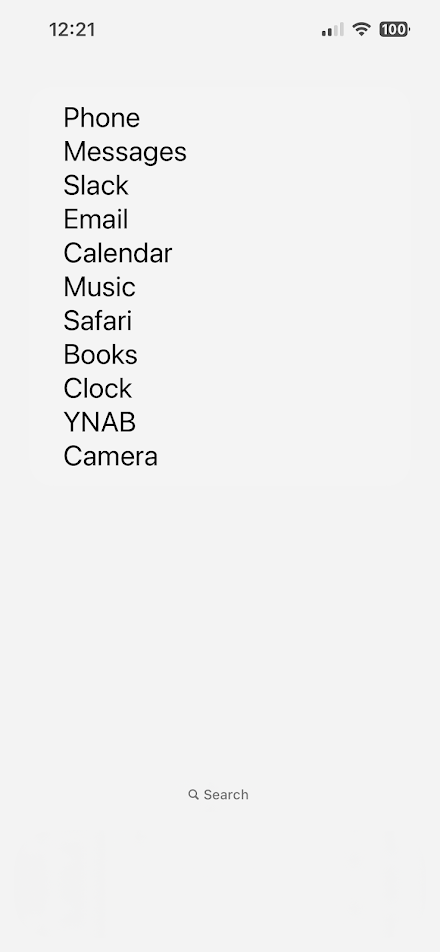
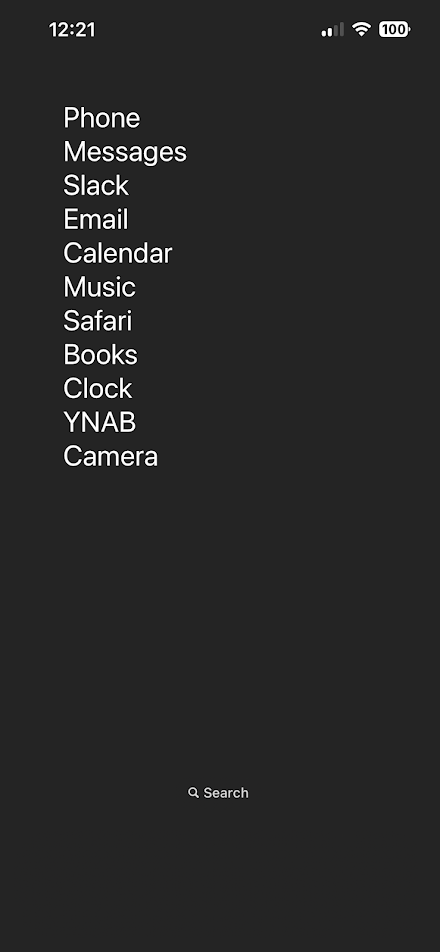
A glimpse into into my own iPhone's Light & Dark home screen
Minimal Home Screen Launcher
One effective method to reduce distractions is to use a minimal home screen launcher. These launchers simplify your phone's interface by displaying a plain list of selected apps, reducing the visual stimuli that colorful app icons provide.
Scientific Support
Visual complexity significantly influences how often we check our phones. The Computers in Human Behavior study mentioned earlier found that participants using simpler interfaces checked their phones less frequently than those with standard interfaces (Bayer, Campbell, & Ling, 2016). By minimizing the visual appeal of your home screen, you can reduce the habitual urge to check your phone.
Practical Application
I did not know about Dumbify prior to last week, and now after a week of daily use, it's now my main home screen. Buyer beware, the app costs $4.99 and offers a straightforward interface without any additional in-app upcharge purchases. Implementing a minimal launcher can create a less engaging and more focused phone environment.
Additionally, I'd like to highlight the Minimis Launcher, a promising alternative to Dumbify that operates on similar principles. As a supporter of this ProductHunt project, I believe that Minimis Launcher shows great potential in simplifying smartphone interfaces and reducing distractions. While Dumbify may currently offer more advanced features, such as further development and refinement, the work being done by Minimis is commendable. You can learn more about Minimis Launcher and its innovative approach at launcher.minimis.life.

Impact on Sports Performance
Reducing visual distractions on your phone can have a significant impact on sports performance. Athletes need to maintain high levels of concentration both during training and competition. By simplifying the home screen and reducing the frequency of phone checking, athletes can minimize mental distractions that can interfere with their focus and preparation. This allows for more dedicated time to visualize techniques, review strategies, and engage in mental rehearsals, all of which are crucial for peak performance.
In a work-professional context, a simplified home screen can enhance productivity by reducing the temptation to engage in non-essential activities. This can lead to more efficient use of time, allowing professionals to concentrate on high-priority tasks. By creating a less distracting digital environment, individuals can improve their ability to manage time effectively, which is a critical factor in achieving long-term goals and maintaining high performance.
Plain Wallpapers (That Hide Your Dock)
Another strategy to simplify your phone is using a plain wallpaper, particularly ones that blend with the dock to make it less conspicuous. This approach reduces the overall visual appeal of your home screen.

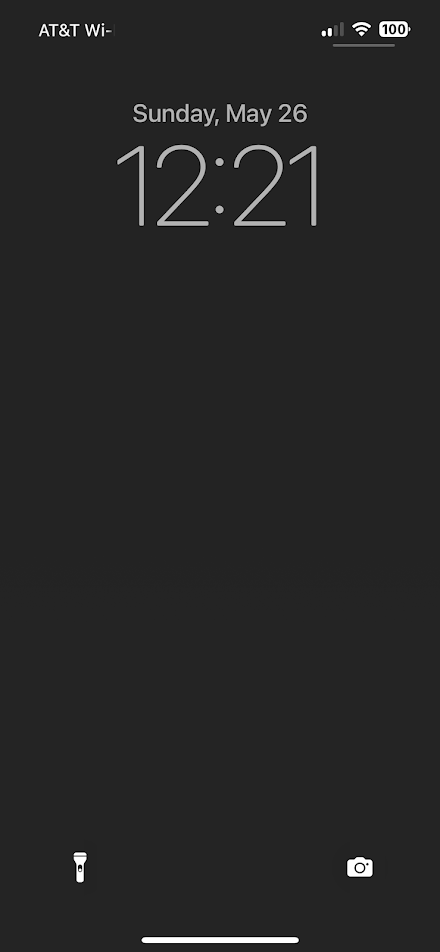
Scientific Support
A visually overstimulating environment can contribute to frequent and unnecessary phone interactions. Reducing this stimulation can help mitigate these interactions. While specific studies on wallpapers are limited, the broader principle of reducing visual stimuli to enhance focus is well-supported in cognitive psychology (Renaud, Ramsay, & Hair, 2006).
Practical Application
Dumbify includes wallpapers that match the iOS dock colors, creating an extremely minimal home screen. To maximize this effect, disable automatic light/dark mode to maintain consistent wallpaper and dock colors (Settings > Display & Brightness > Appearance/Automatic). For a completely bare home screen, turn off the "Search" badge (Settings > Home Screen & App Library > Search/Show On Home Screen).
My minimal setup. pic.twitter.com/6oUf9FSZ0h
— Adam Ringler (@AdamRingler) April 13, 2019
Impact on Sports Performance
The use of plain wallpapers can help athletes by reducing the visual clutter on their phones, allowing them to maintain a clearer mental space. This reduction in visual stimuli can contribute to better sleep quality, as a less engaging phone screen before bed can help athletes wind down more effectively. Better sleep quality is directly linked to improved recovery and performance, making this a valuable adjustment for those in high-performance sports.
For professionals, a less visually stimulating phone can reduce cognitive load, making it easier to transition between tasks without the distraction of colorful or dynamic backgrounds. This can lead to better time management and increased focus during work hours. By simplifying the digital environment, professionals can create a more conducive atmosphere for deep work and sustained attention, ultimately enhancing productivity and job performance.
Grayscale-Only Display
Switching to a grayscale display is a more drastic but highly effective method to reduce phone usage. Color is a significant factor in app engagement, and removing it can decrease the phone’s appeal.
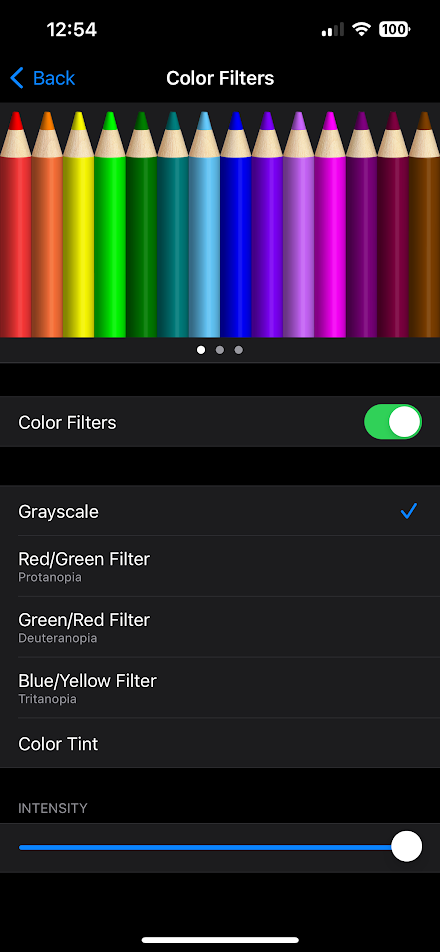

Scientific Support
A study in The Journal of the Association for Consumer Research found that grayscale can reduce engagement by diminishing the rewarding nature of colorful icons and notifications (Lin & Wu, 2019). This reduction in visual appeal can help break the cycle of habitual phone use driven by dopamine rewards.
Practical Application
To enable grayscale, go to Settings > Accessibility > Display & Text Size > Color Filters > Grayscale. You can also set it as an Accessibility Shortcut for easy toggling (Settings > Accessibility > Accessibility Shortcuts > Color Filters).
I discuss my use of iOS grayscale filter on one of my recent Decoding Excellence shows and referenced @tristanharris work and essays quite a bit elsewhere.
— Adam Ringler (@AdamRingler) April 13, 2019
🎧 https://t.co/zgk5WMls60
🎬 https://t.co/K3gotmEMmG
🌐 https://t.co/rlb9ia2Wbn
Impact on Sports Performance
Implementing a grayscale display can significantly aid athletes by making their phones less appealing and therefore reducing screen time. This can free up more time for essential activities such as training, recovery, and mental preparation. Reducing screen time can also lead to better sleep hygiene, as exposure to blue light from screens before bed is minimized, helping athletes achieve deeper and more restful sleep.
In a professional setting, using a grayscale display can help reduce the temptation to engage in non-work-related activities on the phone during critical work periods. This can enhance concentration and focus, leading to increased productivity and the ability to accomplish more in less time. By diminishing the phone's appeal, professionals can maintain better work-life balance and reduce the cognitive load associated with frequent phone interactions.
Disable Notifications
Disabling unnecessary notifications is one of the most impactful changes you can make. Notifications are designed to trigger dopamine releases, making them hard to ignore and disruptive to focus.
Scientific Support
Frequent notifications are associated with increased stress and reduced productivity. A study in Computers in Human Behavior found that individuals who received fewer notifications experienced less stress and were more productive (Renaud, Ramsay, & Hair, 2006).
Practical Application
Manage your notifications by going to Settings > Notifications. Personally, outside of my phone calls and text messages, almost EVERY other notification is turned off for me. On iOS, you can customize your notification preferences per app, and if you’re on iOS 15 or later, schedule a notification summary to further reduce interruptions.
Impact on Sports Performance
For athletes, disabling non-essential notifications can lead to a more focused training environment. Constant interruptions from notifications can disrupt the flow of training sessions, reducing their effectiveness. By minimizing these distractions, athletes can stay more engaged in their training routines and maintain a higher level of mental focus, which is essential for skill development and performance improvement.
In the professional world, reducing notifications can significantly enhance work efficiency. Constant alerts can fragment attention and make it challenging to complete tasks efficiently. By curbing these interruptions, professionals can experience deeper focus and greater productivity, leading to higher quality work and better time management. This reduction in digital distractions can also contribute to lower stress levels, improving overall job satisfaction and mental well-being.
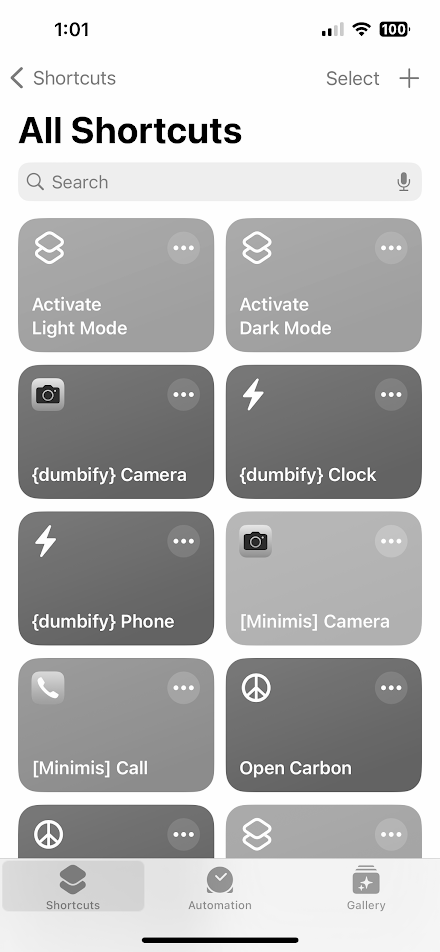

Bonus: Delete Your Apps
The ultimate step in reducing dopamine dependency is deleting addictive apps, such as social media, browsing, and gaming apps. I make it a habit to delete most of the apps on my iPhone that I haven't used in a few weeks. Additionally, I've removed all social media applications like Reddit, Instagram, Facebook, etc.
Scientific Support
Deleting or limiting access to these apps can significantly reduce time spent on smartphones and improve overall well-being. A study in Cyberpsychology, Behavior, and Social Networking highlighted the positive effects of reducing app usage on mental health and productivity (Elhai, Dvorak, Levine, & Hall, 2017).
Practical Application
Consider social-media-free weekends or use apps like Opal and Jomo to regulate usage. Removing app icons can prevent visual cues that trigger usage, making this an effective strategy for reducing engagement. As a warning, Opal is typically a paid application that offers limited features on their free plan and more advanced features for a subscription cost.
Another effective strategy for reducing smartphone engagement is utilizing app blocking applications such as ScreenZen. ScreenZen offers a comprehensive solution for managing screen time by allowing users to block access to distracting apps or websites during specified periods. By implementing ScreenZen, I've been able to create boundaries and limit exposure to digital distractions, thereby fostering a more focused and balanced lifestyle. This proactive approach empowers me to take control of my digital habits and optimize productivity and well-being.

I personally use this application to help setup more advanced app and screen-time limits.
Impact on Sports Performance
Eliminating addictive apps can have profound benefits for athletes. Social media and other addictive applications can consume valuable time that could be better spent on physical training, recovery, and mental conditioning. By removing these distractions, athletes can dedicate more time to activities that directly enhance their performance, such as watching game footage, studying playbooks, or engaging in mindfulness practices.
For professionals, deleting time-wasting apps can lead to substantial improvements in productivity and focus. Without the constant temptation of social media and other distracting apps, professionals can devote more time to meaningful work tasks, leading to higher efficiency and better outcomes. This can also promote a healthier work-life balance, as individuals are less likely to carry work stress into their personal time due to constant digital interruptions.
Conclusion
I challenge you to implement at least one of these strategies. Even a small step, like managing your notifications, can help reduce interruptions and foster a more focused lifestyle.
Reducing dopamine dependency from smartphones isn't an overnight transformation. However, these tweaks can nudge you towards a more productive and balanced digital life. For more drastic results, consider additional measures, but start small and build your digital minimalism journey one step at a time.
References
- Bayer, J. B., Campbell, S. W., & Ling, R. (2016). Connection cues: Activating the norms and habits of social connectedness. Computers in Human Behavior, 62, 223-229. https://doi.org/10.1016/j.chb.2016.03.033
- Elhai, J. D., Dvorak, R. D., Levine, J. C., & Hall, B. J. (2017). Problematic smartphone use: A conceptual overview and systematic review of relations with anxiety and depression psychopathology. Journal of Affective Disorders, 207, 251-259. https://doi.org/10.1016/j.jad.2016.08.030
- Lin, Y., & Wu, T. (2019). Color and psychological functioning: The effect of red on performance attainment. The Journal of the Association for Consumer Research, 4(3), 236-247. https://doi.org/10.1086/703654
- Renaud, K., Ramsay, J., & Hair, M. (2006). "You've got e-mail!"... Shall I deal with it now? Electronic mail from the recipient's perspective. International Journal of Human-Computer Interaction, 21(3), 313-332. https://doi.org/10.1207/s15327590ijhc2103_3


